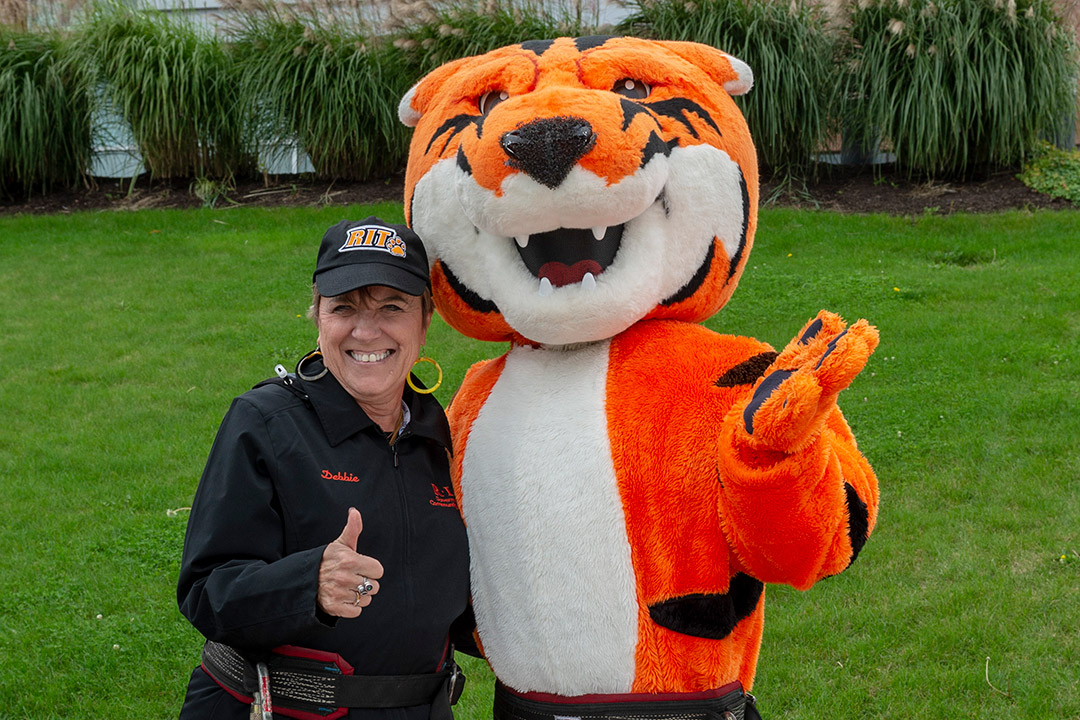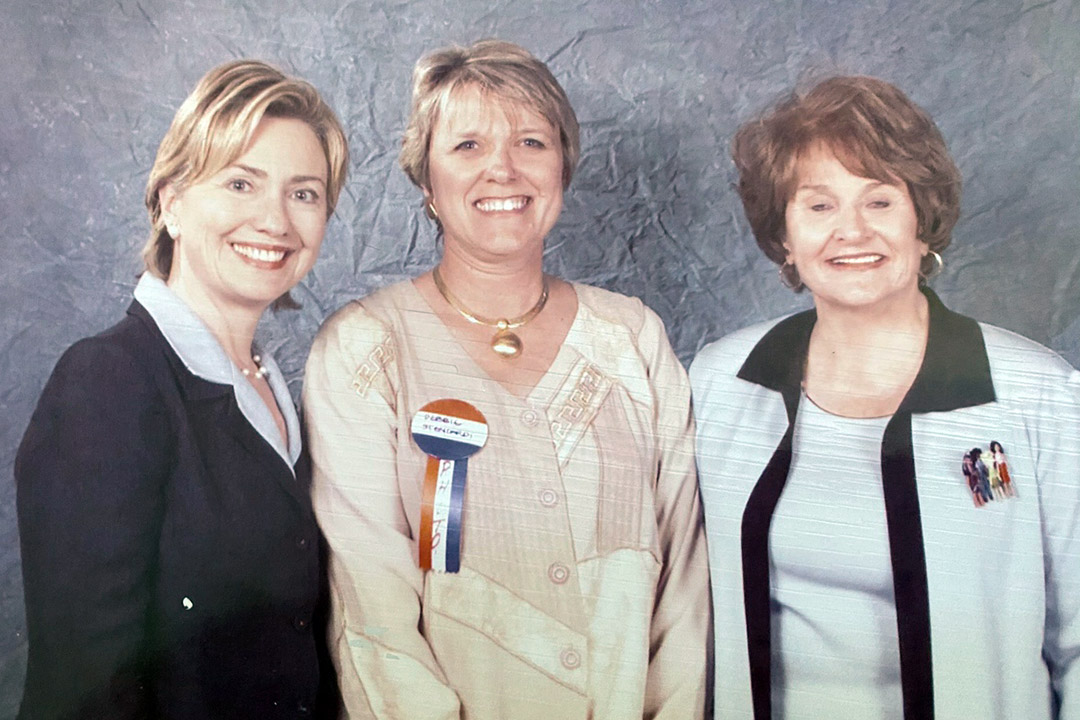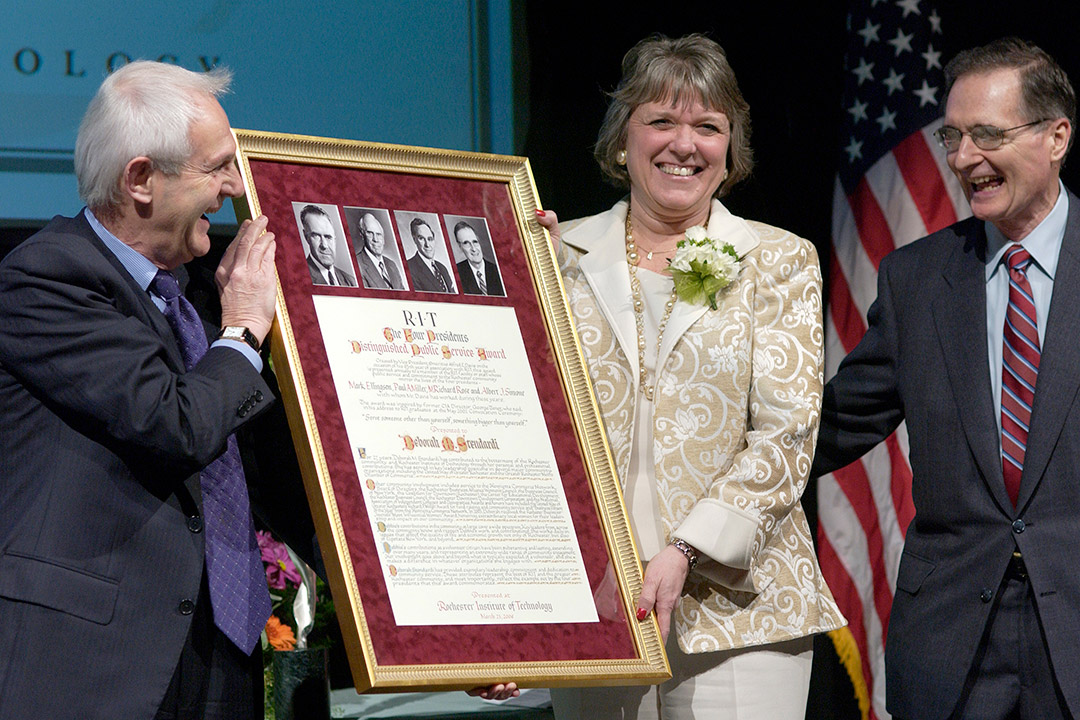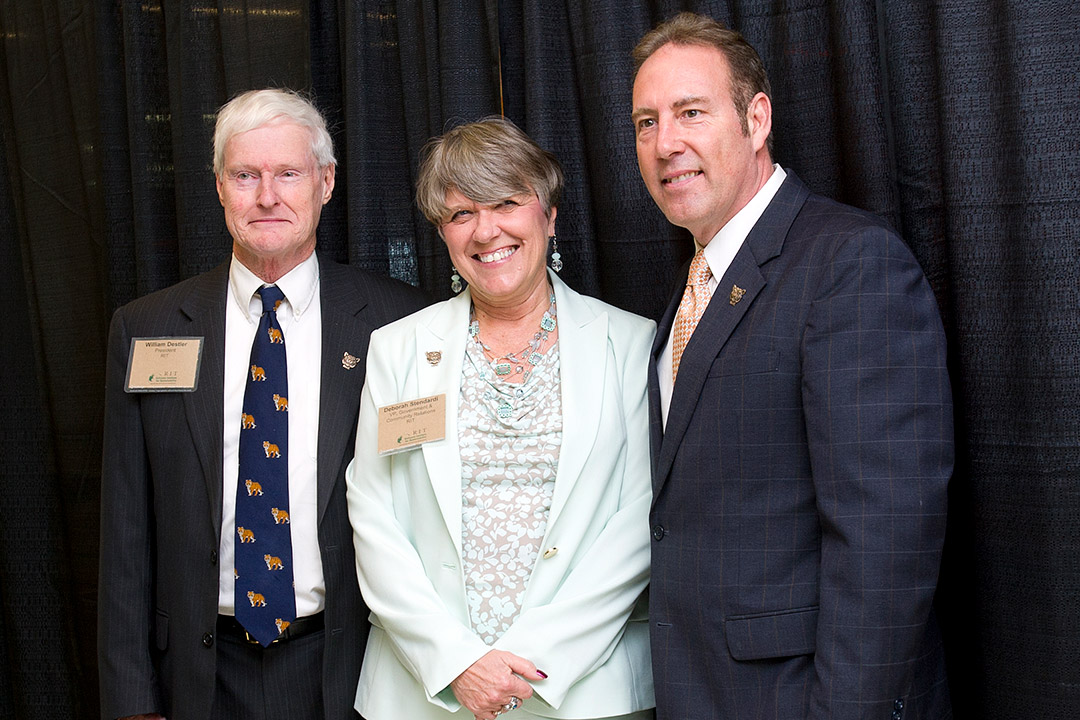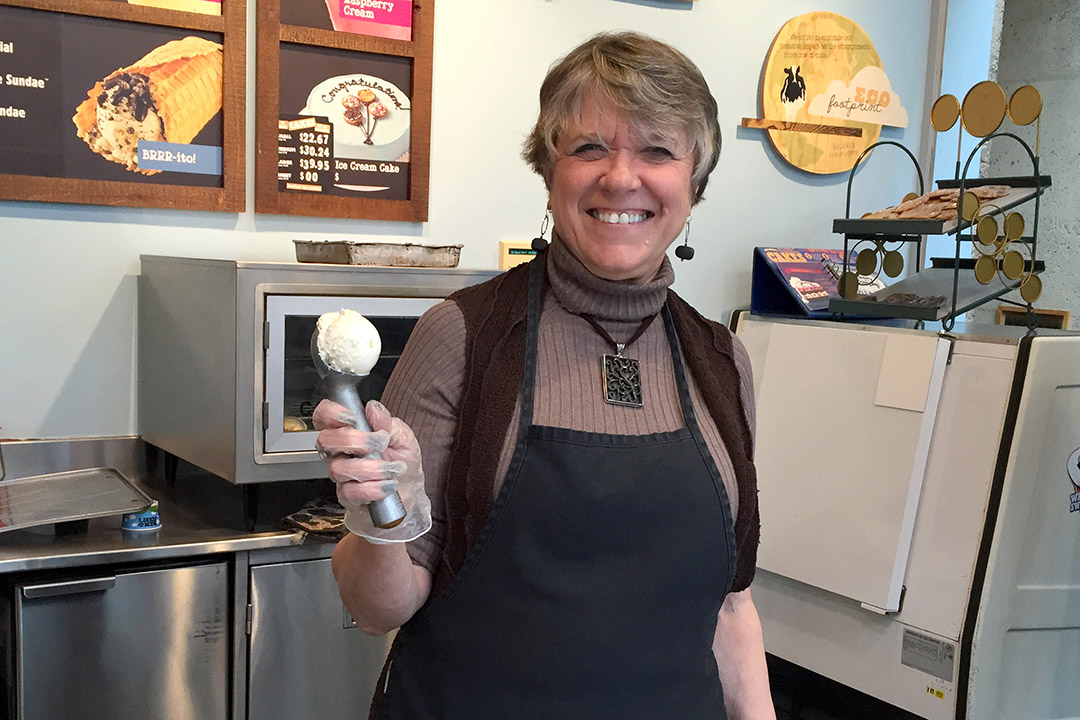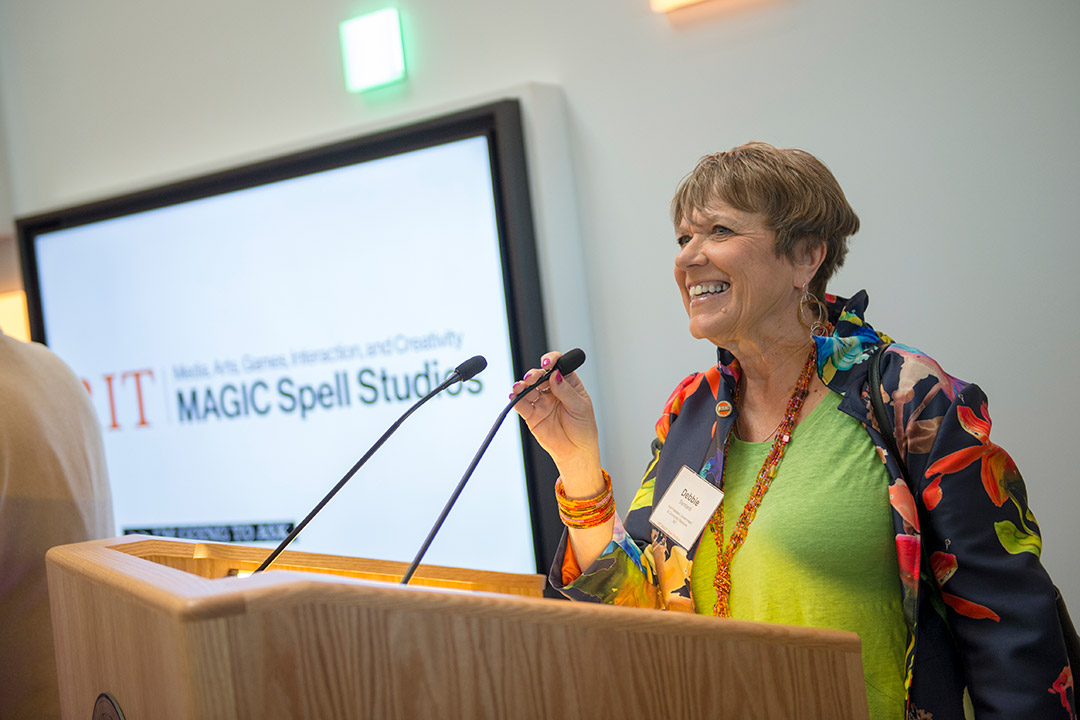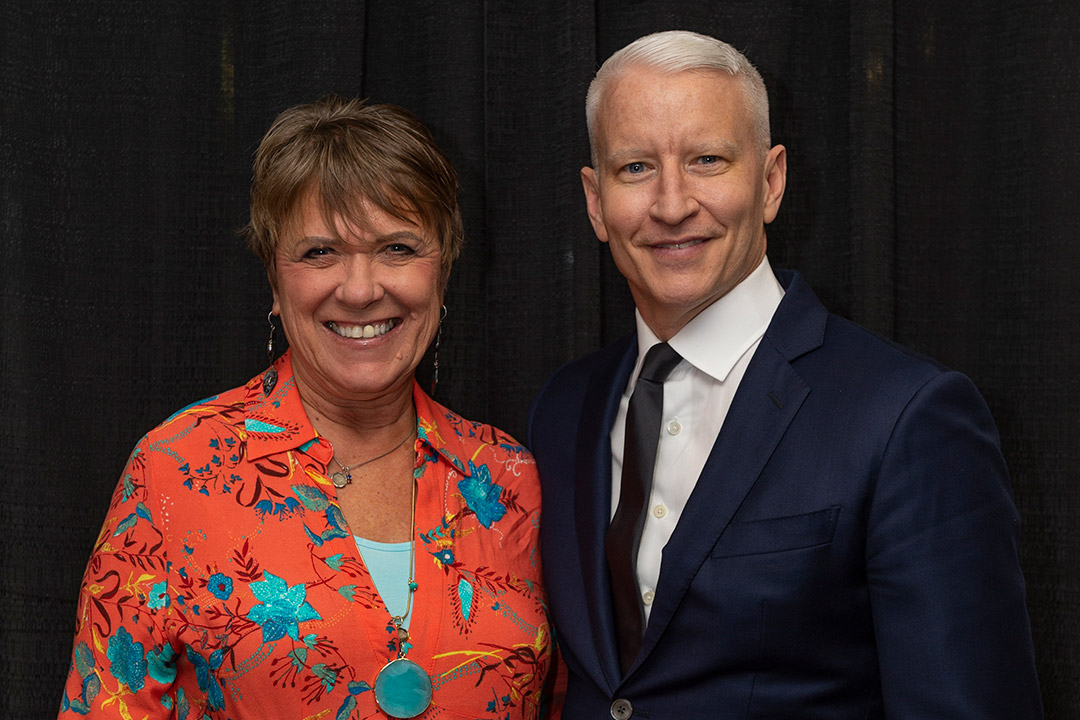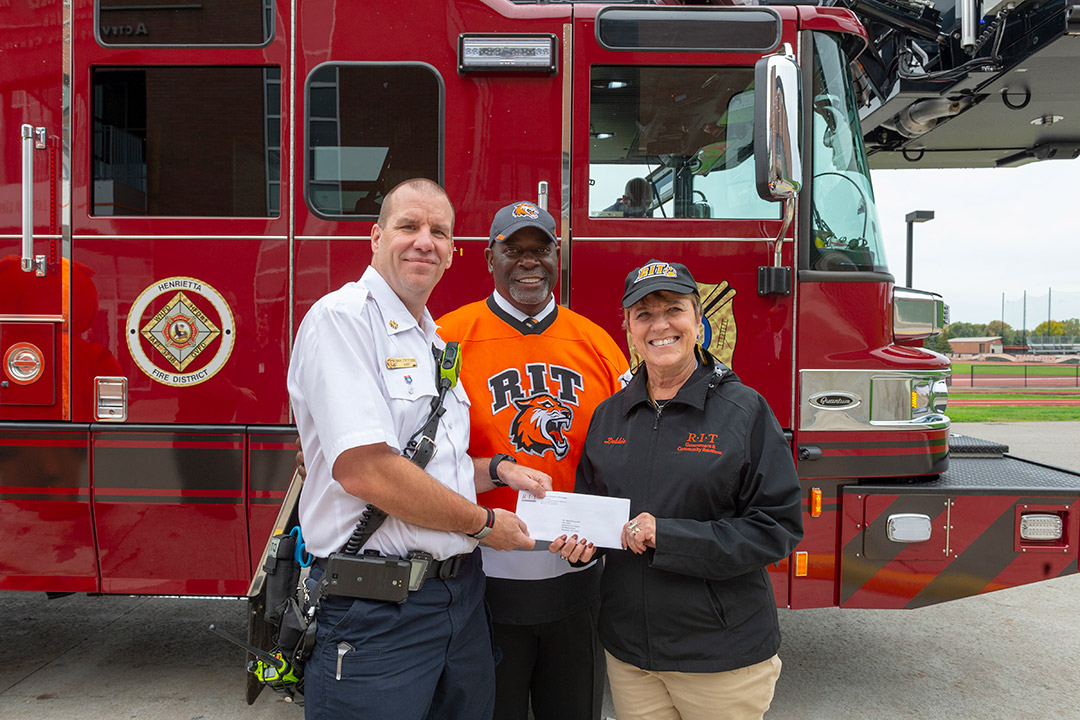Debbie Stendardi reflects on outstanding career as governmental affairs advocate
Retiring VP leaves indelible mark on university, Greater Rochester region after 41 years
Elizabeth Lamark
Debbie Stendardi, who retires as vice president of Government and Community Relations at the end of the year, leaves an indelible mark on both RIT and the Greater Rochester region—both of which she has advanced considerably through her advocacy efforts for more than four decades.
Debbie Stendardi, who retires as vice president of Government and Community Relations at the end of the year, leaves an indelible mark on both Rochester Institute of Technology and the Greater Rochester region—both of which she has advanced considerably through her advocacy efforts for more than four decades.
Stendardi, who began working at RIT in 1979, steps down from a university that has ascended to a world-class research institution and a major economic development force during her tenure. During that time, she built strong, long-term relationships with top political and business leaders, who praised Stendardi for her unstinting efforts on behalf of the university, RIT students, and beyond.
Hillary Clinton, Debbie Stendardi, and Louise Slaughter.
“The level of success that Debbie has achieved by shaping and building the government and community affairs group has been extraordinary,” RIT President David Munson said. “I am deeply appreciative of her tireless efforts and countless contributions that have spanned five RIT administrations. In my relatively short time here, Deb has been a valued advisor and outstanding contributor to the mission of RIT. She will be missed.”
Donald J. Truesdale, chairman of RIT’s Board of Trustees, called Stendardi “an ever-present force of nature in support of RIT.”
“She has established and led countless campus activities that are now signature functions of the university, including creation of the RIT University Magazine, and Brick City Homecoming & Family Weekend. It is hard to imagine an RIT without Debbie.”
Read More
Political and business leaders joined Rochester Institute of Technology officials in congratulating Debbie Stendardi, retiring vice president for Government and Community Relations, on an exceptional career as she prepares to step down at the end of the year. Read their comments.
Among her many accomplishments, Stendardi advocated for financial aid programs to enable more students to benefit from an RIT education. She helped secure funding for groundbreaking initiatives, including Golisano Institute for Sustainability, MAGIC Spell Studios, the AMPrint Center for Advanced Technology, and most recently, the Global Cybersecurity Institute.
Stendardi also has been a vital contributor to countless Finger Lakes Regional Economic Development Council's activities, Greater Rochester Enterprise, and other economic development entities in the region.
In a far-ranging interview, the unassuming Stendardi reflected on her longtime career and widespread impact.
What drew you to want to work in government and community relations, and why RIT?
I always say that it was serendipitous that I ended up with this career, and at RIT. My bachelor’s degree was in early secondary education, but I realized after student teaching that teaching wasn’t the career for me. After getting married in 1973 and moving to Albany, I ended up working at the Commission on Independent Colleges and Universities (CICU), which is the statewide advocacy organization for private colleges. I found that I enjoyed work and I had a great mentor in the organization’s (then) president, Harry "Hank" Paley. When we moved to Rochester in 1979, I had the benefit of knowing all of the presidents of the area colleges and universities. Dr. (M. Richard) Rose had just recently assumed the presidency of RIT and he was looking to set up an office of government relations under the guidance of Dr. Robert Frisina, who became another great mentor to me. So there I was and I have never looked back!
How would you characterize RIT’s evolution during your 40-plus years?
RIT’s trajectory has been nothing short of amazing, and it really started before my time here with President (Mark) Ellingson, who made the strategic and bold decision to move the campus to Henrietta. The RIT Board of Trustees has wisely chosen the right individuals at the right time for the university. Each of the university’s presidents in the “modern” era, if you will, have made their mark on the university in important ways. When I was working at CICU from 1974 to 1979, RIT was a member of the organization, but it was not as engaged in legislative advocacy in Albany. For most of that time, Dr. Paul Miller was RIT’s president and he needed to be very focused on building RIT’s solid academic reputation as well as developing the relatively new campus. Dr. Rose came along in 1979, and he built on that reputation, including starting the first Ph.D. program in imaging science, but he was also interested in expanding RIT’s engagement with federal and state government and in growing government funding. We were able to secure major grants for critical facilities that enhanced the university’s research infrastructure as well as its national visibility, including the Carlson Center for Imaging Science and the Microelectronic Engineering building (now called Semiconductor and Microsystems Fabrication Laboratory). A few years ago, Dave Messinger and the folks in the Center for Imaging Science invited Dr. Rose to visit the center to update him on what they have accomplished, and he was delighted and proud of their success.
A. Sue Weisler
Stendardi received the Four Presidents Distinguished Public Service Award in 2006 from former College of Liberal Arts Dean Andrew Moore, left, and former President Al Simone.
When Dr. Al Simone arrived in 1992, he had a grand vision to take RIT to the next level, and it was fun and exhilarating to be part of that journey with him. To say it was a wild ride would be an understatement! During his tenure, RIT added several major new facilities to the campus landscape, grew enrollment almost exponentially, including graduate students, added Ph.D. programs as well as international campuses and propelled the university to be recognized nationally and internationally as a “category of one” institution. Al’s mantra was “how you start is how you finish!” and he very successfully drove the university to live up to that expectation.
President William Destler continued RIT’s legacy of innovation and progress for the university, creating the Imagine RIT Festival that showcases the university’s talented students and faculty to the community and the world. During his tenure, RIT’s Carnegie Classification changed to a Doctoral university, reflecting the university’s rapid growth in the number of Ph.D. recipients and sponsored research.
And today, President Dave Munson’s dynamic leadership is accelerating RIT’s trajectory as a globally recognized university focused on the intersection of technology, the arts, and design. I think there is no university better suited to prepare the talent needed to address the challenges facing our society and the world. From sustainability to cybersecurity, film and animation to interactive gaming, public policy to astrophysical sciences, and life sciences to personalized health care technologies, RIT has a unique depth and breadth of expertise and a tremendously dedicated faculty and staff that will continue to propel the university forward. President Munson has built a tremendously talented leadership team that ensures great things ahead for the university’s future.
A. Sue Weisler
Former President Bill Destler, Stendardi, and N.Y. State Sen. Joe Robach at Golisano Institute for Sustainability dedication in 2013.
One of the pillars of RIT’s successful evolution has been its financial stability, and for that I do want to especially acknowledge Dr. Jim Watters, who has been RIT’s CFO since 1997 and a trusted advisor to three RIT presidents.
RIT’s external partners in this journey have played a pivotal role in enabling RIT’s growth and success. In particular, our elected officials at the federal and state levels have been extraordinarily supportive and much of what has been achieved would not have been possible without their support and their confidence in RIT’s ability to deliver on what we promise. In fact, it is really a misnomer to call them external partners as they are truly part of the RIT family. Many of these relationships are longstanding and have literally spanned decades, including U.S. Sen. Chuck Schumer, Congressman Joe Morelle, the late Congresswoman Louise Slaughter, N.Y. State Sen. Joe Robach, Assemblymember Harry Bronson, and many others that we have worked with over the years. I am profoundly grateful for their support of the university, and even more grateful to call them friends.
Members of the RIT board of trustees and our contract teams “on the ground” in Albany and Washington have also been important contributors to our success in government relations.
You have played an integral role in many of the university’s strategic initiatives and research expansion over the last four decades. Do any, in particular, stand out?
I’m really very proud of all of the goals that we have been able to achieve on behalf of the university because, as I mentioned previously, we have been able to deliver the results that we had promised. As many folks around the university know, I have had an RIT “bucket list” as well as a personal “bucket list,” and I have been able to achieve a number of them, although not all!
A. Sue Weisler
Stendardi serving up ice cream during a United Way fundraising event in 2016.
Of course, there have been some initiatives that I think have had a particularly significant impact on the university’s growth and reputation and certainly the success of Golisano Institute for Sustainability, and the designation of its offspring, The REMADE Institute, as one of a handful of Manufacturing USA institutes stands out as a major milestone for RIT. Nabil Nasr and his team have been incredible partners in advancing RIT at the federal and state level over several decades.
I’m very proud of the success of the Chester F. Carlson Center for Imaging Science, one of the very first major initiatives that I worked on in the mid-80’s, starting with the important work of Dr. John Schott in remote sensing and today under the leadership of Dave Messinger being a critical national resource for applications of digital imaging and remote sensing in a wide range of global challenges.
Our Center of Excellence in Advanced and Sustainable Manufacturing and the AMPrint Center, our Center for Advanced Technology in Additive Manufacturing and Multifunctional Printing, were long sought goals that I believe have catapulted RIT’s reputation at the state level and I’m proud of the work that these centers are doing to help our company partners and strengthen our region’s economic growth and development.
I have to say that MAGIC Spell Studios, also a New York state-designated Center of Excellence, was one of the most fun projects I worked on and both the formal “groundbreaking” and “ribbon-cutting” ceremonies for that building were all-time favorites for the uniqueness of the celebrations. What is happening in that facility today is very exciting and I think it will be a beacon of success for RIT for many years to come.
Elizabeth Lamark
Stendardi at the opening of the MAGIC Center in 2018.
Of course, it’s all about the students and the opportunities that these initiatives provide for RIT to provide the very best academic experiences. Working with my colleagues across the state through our association with CICU on funding for programs that enable students to attend independent institutions such as RIT has been particularly gratifying as well. Since my roots in the academy stemmed from my days at CICU, it has been fortuitous to be able to continue that relationship in my work here at RIT.
One last thing, and this may surprise some folks, but one of the things I am most proud of is the RIT University Magazine, which I started in 1999. I’ve had the pleasure to serve as one of the executive editors for the last 21 years, and it has been one of the great vehicles to chronicle RIT’s evolution to the university it is today.
How would you like people at the university, the Greater Rochester community and beyond to remember you?
When I came to Rochester in 1979, I immediately felt the sense of community in the region, and I remember thinking that I would like to be able to make an impact, following the example of many leaders who I had the privilege to get to know and to work with. So I got involved with civic organizations such as the United Way, the Downtown Development Corporation, and the Chamber of Commerce. I’ve also served on committees for the City of Rochester Sesquicentennial Celebration in 1984, and two anniversary committees for the Town of Henrietta (its 150th and its 175th), and co-chaired RIT’s 175th anniversary committee. And I currently serve on a number of community boards, including the United Way.
I would like to be remembered as a collaborator who worked well with others across the university and the community, and who looked to bring people together to achieve mutual goals. The role that RIT plays as an economic driver in the region and the respect and esteem it engenders makes me feel truly privileged to have had the opportunity to serve the university for these 41 years.
I hope that I’ve been a good manager and mentor for my Government and Community Relations team. They are a dedicated and hardworking group, and an asset to the university, and I’m thankful to them for all of their efforts and support over many years. I’ve always said GCR is a small division with a big impact and I’m very proud of what we have achieved together on behalf of the university.
Elizabeth Lamark
Stendardi and Anderson Cooper at a Brick City Homecoming event in 2019.
I’ve always felt that it was important that the relationships we build for the university transcend the individuals who are here for a time and then move on. When you are able to do that, but also maintain wonderful personal friendships as well with many of the elected officials, other colleagues, and community leaders that I have worked with, it is both rewarding and humbling.
A friend and colleague in Albany, who also happens to be an RIT alum, once told me that every time he reads about RIT’s latest achievement or success, he feels the value of his RIT degree go up and it increases his pride in being an RIT graduate. While I do not have the benefit of an RIT degree, I will continue to watch RIT’s future trajectory with a similar sense of pride in knowing that I was able to help lay some of the foundation for that success.
What’s next in retirement?
My personal bucket list is a long one, especially related to travel destinations, so hopefully when borders open up again, my husband and I will be able to take some trips abroad as well as domestically. Spending more time with children and grandchildren and other family that we haven’t been able to see in a while is of course a priority. My “posse” of girlfriends and I will be looking to a return trip to Nashville, and to get to as many concerts and shows as we possibly can (we have been in withdrawal during this pandemic)!
Elizabeth Lamark
Henrietta Fire Chief Mark Strzyzynski, left; Howard Ward, associate vice president for Student Auxiliary Services, and Stendardi in 2019.
I would like to stay involved in the community where I can be helpful. I am not a Rochester native, but I have lived here longer than anywhere else and this community means a lot to me. It is where we raised our children and planted strong roots. It is a great place to live and I want it to be able to live up to its potential as a dynamic 21st century mid-size city.
My hobbies include photography and making photo books of family history and travel adventures, golf (not very good at it and probably never will be), pickle ball (better at that than golf), and reading. So more of all of that and time on Keuka Lake and the Lake of Bays in Canada.









